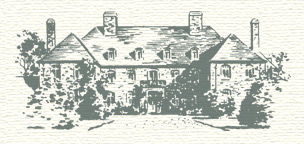 "Mother
told us that on a summer holiday which she and Father were spending
with his parents in Rye, Grandfather [learned that] the Brown farm of
about 100 acres on Milton Point was to be sold at auction. Grandfather
said he thought he would just go down to the Point to see what
happened. Grandmother said she cautioned, 'Now, Howard, don't do
anything foolish!' Grandfather disclaimed any such intention. However,
on his return, she said, he looked rather sheepish, so she asked,
'Howard, what on earth have you done?' To this he replied laughingly,
'Mag, I've been and gone and done it. I bought the whole Point!" "Mother
told us that on a summer holiday which she and Father were spending
with his parents in Rye, Grandfather [learned that] the Brown farm of
about 100 acres on Milton Point was to be sold at auction. Grandfather
said he thought he would just go down to the Point to see what
happened. Grandmother said she cautioned, 'Now, Howard, don't do
anything foolish!' Grandfather disclaimed any such intention. However,
on his return, she said, he looked rather sheepish, so she asked,
'Howard, what on earth have you done?' To this he replied laughingly,
'Mag, I've been and gone and done it. I bought the whole Point!"
Throughout generations of Wainwrights and their Mayhew ancestors, a
remarkable family trait keeps re-emerging: a willingness to make
life-changing decisions on the spur of the moment somehow coupled in
the same person with a deep commitment to serve community, country, and
God. Spontaneity and dedication seems like a marriage of opposites. It
is this remarkable, catalytic combination, which has so much to do with
how Wainwright House was created and what it is today. The story begins
like this...
The first Wainwright emigrated to the U.S. in the 1780's. Eventually
settling in Rye, the Wainwrights became one of Rye's most influential
families. John Howard Wainwright and his wife Margaret (a direct
descendent of New York Gov. Peter Stuyvesant) bought Milton Point in
1864 and summered there with their four sons, who later built houses
along Stuyvesant Avenue (yes, the road is named for their mother's
family). These buildings include Wainwright House, Panetiere
Restaurant, Coveleigh Club, The Anchorage, The Willows, and a large
brick home near Hall's Lane.
The youngest son was Colonel J. Mayhew Wainwright. He became a state
assemblyman, state senator, U.S. congressman, Assistant Secretary of
War, and a much-decorated lieutenant colonel in World War I. When he
was in Doullens, France, he was headquartered at a 17th century chateau
called Raincheval, which came to have a great impact on him. On the eve
before he was to lead his men to battle, he promised himself that if he
came through the war alive and made it back to Rye, he would build a
chateau resembling Raincheval on the family land on Milton Point. He
did, completing Wainwright House in 1931. Col. Wainwright was active in
Rye's Christ Church for more than 24 years, first as a vestryman then
as a warden.
He served on the Westchester County Parks Commission and on the boards of the Seamen's Church institute and St. Luke's Hospital.
His brother John Howard Wainwright, Jr. was a Rye trustee in the early
1900's. Another brother was Richard, an architect who designed his own
home, Coveleigh, and was Commodore of American Yacht Club. His third
brother Stuyvesant, who owned Anchorage, was an avid sailor and a deck
officer in WWI. A later cousin, Gen. Jonathan M. Wainwright, was a hero
of the battles of Bataan and Corregidor during WWII. Looking further
back, Col. Wainwright's grandfather, Jonathan Mayhew Wainwright (1792-
1857), was Episcopal Bishop of New York. In New England during the
1600's and 1700's, Col. Wainwright's Mayhew ancestors were ministers
and politicians- most notably Gov. Thomas Mayhew, who later in life
became a missionary, and Rev. Jonathan Mayhew, who founded Unitarianism
in New England.
Col. and Mrs. Wainwright had one child, their daughter Fonrose. In the
late 1940's Fonrose suffered the lost of both her parents and her
husband in the space of just a few years. Whereupon, through a series
of apparent coincidences, she met a then unknown young minister, Norman
Vincent Peale. It is said that Peale walked through the door of
Wainwright House, stopped suddenly and remarked with awe that even
though it was empty and unused, the house was filled with love. Fonrose
knew then she had found a compelling use for her parent's home. In
1951, she founded Wainwright House, Inc. With the belief that there
should be a place under one roof where people from all backgrounds and
all beliefs and even no beliefs at all- could aspire for a greater
understanding of the creative force of life we call God. |
| What is Wainwright House Today? |
Wainwright
House is the oldest non-profit, non-sectarian holistic learning center
in the United States. Our mission is to inspire greater understanding
through body, mind, spirit and community. In this sacred space, we seek
to inspire by offering initiatives in spiritual exploration, health and
healing, cultural enrichment, and environmental awareness.
Teachers have included Thomas Berry, Joan Borysenko, Rosalyn Bruyere,
Ralph Bunche, Joseph Campbell, Deepak Chopra, Ram Dass, Mathew Fox,
Michael Harner, Jean Houston, Aldous Huxley, Craig Junjulus, Dolores
Krieger, Thomas Moore, Bernie Siegel, Sir Laurens Van Der Post, and
Roger Woolger, to name but a few. Early supporters included Dwight
Eisenhower, J.C. Penney, and John D. Rockefeller.
Join us and experience tranquility and inspiration on Wainwright
House's five acres of lawns and gardens overlooking Milton Harbor on
Long Island Sound. Facilities include three buildings with meeting
rooms, dining rooms, a meditation room, library, and solarium; also the
Yoga Center and lodging for programs and retreats.
Wainwright House is available for meetings and events and rental by
non-profit and civic organizations. For more information call
914-967-6080. |
|
|
|